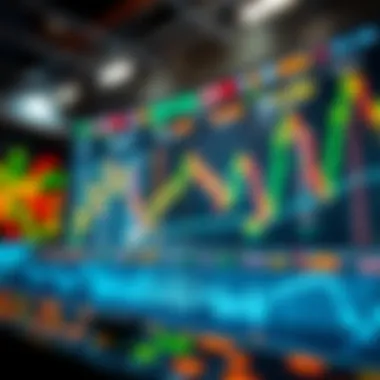Understanding Futures Trading: Insights and Strategies


Intro
The futures trading market serves as a vibrant and complex arena where traders and investors can speculate on the future prices of various assets. Understanding this market involves comprehending its operational mechanics, as well as the implications it holds for those engaged in trading. This ever-evolving landscape not only presents opportunities but also risks that are intrinsic to trading activities.
The environment is influenced by a multitude of factors, including fluctuations in supply and demand, macroeconomic indicators, and even geopolitical events. For someone stepping into this field, grasping these nuances is crucial. By engaging with this article, you will encounter a detailed exploration of contract types, effective risk management strategies, and the psychology that drives human decision-making in trading.
What follows is a deep dive into one of the most dynamic areas of finance today, all designed to enhance your understanding and perhaps even inspire confidence in your trading endeavors.
Understanding Futures Trading
Futures trading is an intricate topic, essential for anyone keen on making sense of the financial world. At its core, understanding futures trading sets the stage for grasping how speculative ventures, hedging, and risk management intertwine in day-to-day financial practices. This sector is not just a playpen for day traders but a significant tool for institutional players, like farmers, investors, and businesses, allowing them to manage price volatility effectively.
By delving into the mechanics of futures trading, readers gain insight into not only how to parse contract specifications but also how to strategize and position themselves for potential market movements. This understanding ultimately helps traders and investors safeguard their interests and capitalize on price fluctuations across various asset classes.
Definition of Futures Contracts
A futures contract represents a standardized agreement where two parties commit to buy or sell an asset at a predetermined price on a specified future date. These contracts typically cover a wide array of underlying assets, such as commodities like wheat and oil or financial instruments like currencies and stock indices. It’s crucial to understand that these contracts are often traded on exchanges and are designed to minimize counterparty risk through an intermediary, typically a clearinghouse.
In practical terms, a trader looking to hedge against potential price drops in wheat could purchase a wheat futures contract, locking in a price to sell their actual wheat crop later, ensuring they are not at the mercy of market volatility when harvest time arrives.
Be mindful that futures contracts aren't purely about ownership; they represent a legal obligation for the contract’s terms, which distinguishes them from options, where the right to buy or sell is an option, not a requirement.
Historical Context and Evolution
The concept of futures trading isn't a modern phenomenon; its roots trace back hundreds of years. Originally, traders relied on informal agreements and verbal contracts. The formalization of futures contracts began in the 19th century with the establishment of the Chicago Board of Trade in 1848. This institution offered a structure that allowed for the documentation and trading of standardized contracts, which significantly minimized the risk of default by the counterparties involved.
Initially, the contracts largely focused on agricultural commodities, following the simple needs of farmers who sought protection against fluctuating prices for their crops. Over time, as markets evolved and the economy became more complex, futures contracts began to encompass a broader range of assets, including not only agricultural products but also energy, metals, and financial securities.
Today, futures trading operates on a global scale with innovations that enhance trading efficiency and accessibility—such as electronic trading platforms. Market participants now range from individual speculators to large hedge funds, each utilizing futures contracts for various purposes, from hedging to speculative trading.
"Futures contracts have transformed into a critical tool that not only paves the way for speculators but also supports hedgers in managing risk amid market uncertainties."


Understanding futures trading, therefore, offers a window into how modern economies function and adapt over time, grounded in both historical precedence and contemporary adaptations.
Types of Futures Contracts
The landscape of futures trading is as diverse as the products it encompasses. Understanding the various types of futures contracts is crucial for anyone looking to navigate this market. Each contract serves different purposes and caters to varying risk appetites. By delving into each category, traders and investors can make informed decisions that align with their strategies. Let's take a closer look at three primary types of futures contracts: commodity futures, financial futures, and index futures.
Commodity Futures
Commodity futures are perhaps the most traditional form of futures contracts. These contracts involve the buying and selling of a specific quantity of a commodity at a predetermined price on a future date. Commodities can range from agricultural products like wheat and corn to energy products like oil and natural gas. The significance of commodity futures lies in their role in hedging against price fluctuations. For example, a farmer may lock in the price of corn before the harvest, ensuring financial stability despite potential price drops.
The advantages of trading commodity futures include:
- Hedging: Producers and consumers can manage their exposure to price volatility.
- Price Discovery: The futures market helps determine the current market price based on supply and demand dynamics.
- Leverage Opportunities: Traders can control large positions with relatively small capital input due to margin requirements.
However, it's essential to consider the risks involved. Commodities can be highly volatile, and unexpected events like weather disasters can significantly impact prices. Knowing these elements is pivotal before diving into commodity futures.
Financial Futures
Financial futures focus on financial instruments, contrasting with the tangible assets found in commodity futures. They include futures contracts based on equity indices, interest rates, and currencies. By utilizing financial futures, traders can speculate on the future prices of these instruments without needing to own the underlying assets.
For instance, a trader can hedge against potential interest rate movements by entering into interest rate futures. This form of futures contract is invaluable for institutions such as banks, which need to manage their exposure to interest rate risks.
A few key points about financial futures are:
- Liquidity: These contracts often see high trading volumes, making entries and exits easier for traders.
- Diversification: Investors can gain exposure to multiple asset classes through these contracts, thus spreading their risk.
- Speculative Opportunities: Traders can profit from fluctuations in financial markets without direct asset ownership.
Nonetheless, market participants must be wary. Financial futures can be highly sensitive to economic data releases and geopolitical events. A sudden change in market sentiment can lead to sharp price movements.
Index Futures
Index futures specifically relate to stock market indices such as the S&P 500 or the Dow Jones Industrial Average. These contracts enable traders to bet on the performance of a specific index rather than individual stocks. With index futures, investors can take a position on the overall market trend, simplifying their market exposure.
The key benefits of index futures include:


- Efficiency: Traders can gain exposure to the entire market or a segment of it without having to buy each stock individually.
- Hedging Mechanism: Portfolio managers can hedge against market downturns by taking short positions in index futures, mitigating potential losses.
- Cost-Effective: The use of leverage reduces the capital required to place trades relative to buying individual stocks.
However, they also carry inherent risks. As with other futures, leverage can amplify losses just as it can amplify profits, making it crucial for traders to manage positions prudently.
Ending
In exploring the types of futures contracts, it's evident each category serves distinct purposes and carries its advantages and risks. Understanding these differences can empower traders and investors to develop efficient strategies that align with their market outlook and financial objectives. Therefore, whether one is dealing in commodity futures, financial futures, or index futures, a comprehensive grasp of these contracts is essential for navigating the futures trading market effectively.
"The futures market offers tools not just for speculation but also for risk management, which is crucial in today’s volatile economic climate."
For more on futures trading and its various dimensions, you might consider visiting educational resources at Investopedia, CME Group, or Wikipedia.
Ultimately, as you chart your course through the vast ocean of futures trading, marked by financial futures, commodity futures, and index futures, remember that informed decisions stem from a thorough understanding of your options.
Market Structure and Key Participants
The structure of the futures trading market is crucial to understanding its dynamics. It encapsulates the venues where trading takes place, the roles of key players involved, and the governance that oversees these transactions. Knowing who the market participants are can make a notable difference in how traders strategize their approaches, balancing the risks and rewards inherent in futures contracts.
Market Exchanges
Market exchanges act as the beating heart of the futures trading system. They provide the platform where buyers and sellers convene, facilitating the exchange of futures contracts. Prominent exchanges like the Chicago Mercantile Exchange (CME) and the Intercontinental Exchange (ICE) play a vital role in establishing market prices and ensuring liquidity.
Each exchange has its unique features:
- Trading Hours: These can vary significantly, with some exchanges operating around the clock.
- Contract Specifications: Exchanges define what is being traded, including the size of contracts and tick sizes, which need to be understood thoroughly by market participants.
- Electronic vs. Floor Trading: While traditional exchanges relied on physical trading floors, electronic trading is now the norm, increasing efficiency and accessibility.
In essence, exchanges create a framework wherein price discovery occurs, influencing everything from individual trades to macroeconomic trends.
Hedgers vs. Speculators
In the realm of futures trading, two primary groups vie for influence: hedgers and speculators, each with distinct motivations and strategies.


Hedgers are typically producers or consumers of the underlying asset. For instance, a farmer expecting to harvest wheat may sell futures contracts to lock in prices, as a means to protect against downturns in market price. This ensures surety in budgeting and revenue forecasting.
Conversely, speculators are those whose aim is to profit from market fluctuations without any interest in the actual commodity. They thrive on price volatility, often using leverage to amplify their gains—or losses. Some characteristics of speculators include:
- Risk Tolerance: They usually possess a higher risk appetite, ready to engage in trades that involve substantial volatility.
- Market Analysis: Speculators rely heavily on technical and fundamental analysis to time their trades effectively.
Understanding the interplay between hedgers and speculators teaches one how market sentiment can shift, creating opportunities for traders on different ends of the spectrum.
Regulatory Bodies
Regulation is the glue that holds the futures trading market together. Various regulatory bodies, such as the Commodity Futures Trading Commission (CFTC) in the United States, ensure market integrity and protect participants from fraud and manipulation. These bodies enforce and establish rules around:
- Market Surveillance: Monitoring trading activities to prevent illegal practices.
- Reporting Requirements: Mandating that traders disclose their positions to maintain transparency.
- Consumer Protection: Safeguarding the interests of retail investors, ensuring they have access to accurate information and a fair playing field.
The involvement of regulatory entities helps to foster trust in the system. Traders can operate with the assurance that the market is under constant scrutiny, making it less likely for malpractices to go unchecked.
"Knowledge of the market's structure is paramount; it informs every strategic move a trader makes in pursuing profitability."
Useful Resources
- CFTC Official Site
- CME Group
- Investopedia: Futures Contract
- Britannica’s Overview of Futures Trading
- Reddit Futures Trading Community
Mechanics of Futures Trading
Understanding the mechanics of futures trading is crucial for anyone engaging with the market, whether they are seasoned traders or newcomers. This section delves deep into the fundamental elements that dictate how futures contracts operate, emphasizing aspects such as margin requirements, order types, and settlement processes.
Grasping these mechanics not only enlightens participants on how transactions are executed but also informs their strategic decisions, risk assessments, and overall trading approaches.
Margin Requirements
Margin is the very lifeblood of futures trading. It refers to the funds that traders must deposit with their broker to open and maintain a position. This collateral protects against potential losses and ensures that both parties are committed to their trades.
A common saying is "it takes money to make money," and this holds particularly true in the futures market. The required margin can vary widely based on the type of futures contract, prevailing market conditions, and the broker’s policies. Typically, traders face two types of margins: initial margin and maintenance margin.
- Initial Margin: This is the upfront deposit required to enter a trade. It's akin to a security deposit when renting a home.
- Maintenance Margin: This is the minimum balance to maintain a position. If your account falls below this threshold, further action may be necessary, like adding funds or closing your position.
plaintext Key Point: The margin not only acts as a security measure but also allows traders to use leverage, meaning they can control larger positions than their outright capital.















